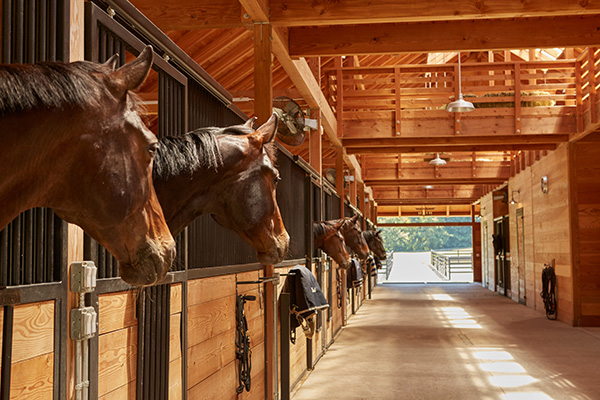Top Three Considerations When Selecting Your Horse Stalls

By Classic Equine Equipment
There are a lot of things to consider when selecting stalls for your horse barn, including animal comfort and safety, functionality and style. Three of the most important factors are stall door styles, the design of the stalls, and water/feeders.
Sliding Versus Hinged Stall Doors
While there is plenty of variety between stall designs, stall doors come in just two basic styles — sliding and hinged.
Sliding stall doors are a popular option for many horse barns. Since these doors do not swing outward into the barn aisle, they provide a major space-saving advantage. This makes sliding stall doors ideal for busy facilities where multiple horses are frequently coming and going, or for facilities with a narrow barn aisle.
Another advantage is that sliding stall doors offer ease of use and provide better control, since handlers only need to use one hand to open the door when guiding a horse into the stall.
Hinged doors are aesthetically pleasing because they make it possible to have an open stall plan while also providing an elegant appearance for your barn. Because hinged doors need room to swing outward, your barn aisle must be fairly wide, especially if you have two rows of stalls directly across from each other. You will also want your barn aisle to be free of items like tack boxes so that you can easily navigate the aisle with a horse.
Carefully evaluate your barn design to select the door style that will best meet your needs. With sliding doors, the placement and direction of the doors are important factors for maximizing the efficiency of cleaning your barn, feeding horses and maneuvering them throughout the barn. For hinged stall doors, also take into consideration door height, floor slope and clearance.
Stall Design
Your horses spend a lot of time in their stalls. Here are some tips to keep your equine companions comfortable and safe.
-
- Stall size – While smaller horses or ponies can get by with a 10×10 ft. stall, most horses need at least 12×12 feet. Warmbloods or mares with foals may require larger stalls. As a rule of thumb, stall length should be 1 ½ times the length of the horse so they have room to turn around and lay down.
- Partitioning Walls – Provide a stall divider of at least 7 ½ feet between your horses’ stalls. A partitioning wall with an upper half grill at least part of the way across lets your horse see the other horses without annoying them or causing trouble. Open space at the top of the stall dividers helps the air circulate within the stall interior.
- Material strength – A stall is only as good as the material that it is made of. And horses can put those materials to the test. Choosing high-quality materials from the start will ensure that your horses remain safe and comfortable for many years.
- Ceiling – Plan for a ceiling at least 11 feet tall to help your horses avoid hitting their head if they should rear up in their stall.
- Light and fresh air – Windows and doors will allow your horses to see out, further minimizing boredom. Plenty of fresh air will help reduce respiratory problems.
- Door width – Doors should be wide enough so the horses can comfortably and safely pass through. Doors with yokes or Dutch doors allow your horses to hang their head outside and watch what’s going on.
- Latches – Install latches on the doors so horses are not tempted to try to escape.
- Hinges – Secure hinges and hardware will help ensure that nothing in the stalls breaks and becomes a danger.
- Flooring – Provide a floor that is comfortable for your horse to stand and lay on, including stall mats.
Water and Feeders
In addition to the basics for comfortable and safe stalls, there are several options for water and feeding systems to consider. These can include:
-
- Swing-out feed options are built into stall fronts to make feeding quick and easy. These feeding options are practical for those helping with the daily chores. This provides easy access to feed without having to enter the stalls.
- Corner grain feeders make it convenient and easy for your horse to eat his grain. Look for one with a rolled top lip that is rolled inside to keep grain enclosed. Buy one with rugged, durable construction and no sharp edges.
- Wall mounted hay feeders are a feed option that helps keep hay off the ground. Ones with a large open design fit well into underused corners. There are also larger sized floor mount options that let you feed hay and grain from the same feeder and include two inserts for salt and grain.
- Automatic horse waterers often come in either corner or wall mount designs. They keep a constant source of clean water available and are easy to clean, and many come with heated water options.
About Classic Equine Equipment
From horse stalls to barn doors, stable flooring and entrance gates, Classic Equine Equipment offers the widest line of high-quality products in the industry. Working closely with you and your architect or builder, we can help create an environment that you’ll be proud of — one that is stylish, that will allow you to care for your horses in an intuitive way and that gives you the peace of mind that comes from knowing your horses are protected by the finest equipment available. Our sales team is knowledgeable about everything from horse barn design to equine stall systems and readily available to assist you in planning your barn. For more information, visit classic-equine.com.

Photo Credit: Patrick Barta
